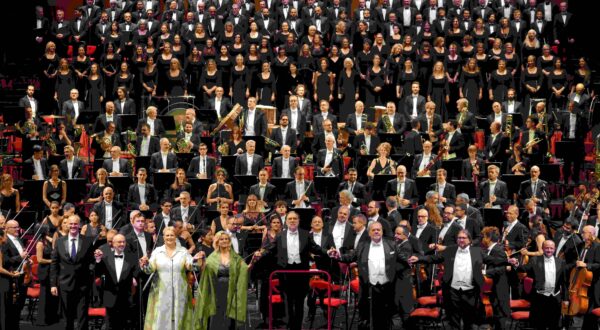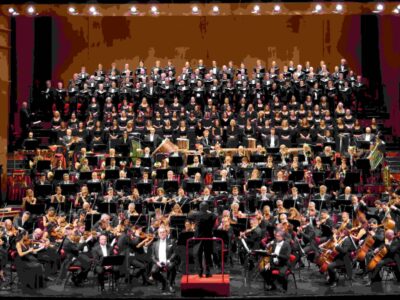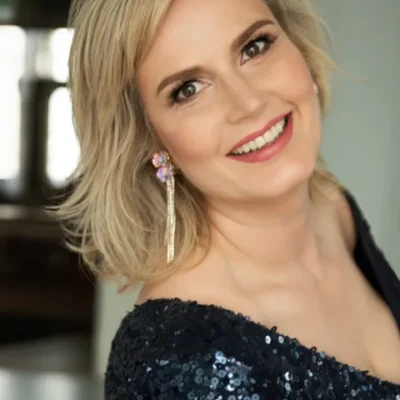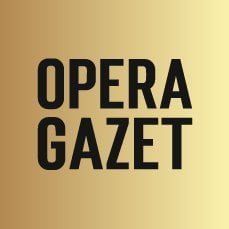GURRE-LIEDER
Gurre-Lieder by Arnold Schönberg, for soloists, chorus and orchestra
La Scala presents a transparent, penetrating rendition of Schönberg’s sprawling cantata
Conductor RICCARDO CHAILLY
Waldemar ANDREAS SCHAGER
Tove CAMILLA NYLUND
Waldtaube OKKA VON DER DAMERAU
Bauer und Sprecher MICHAEL VOLLE
Klaus Narr NORBERT ERNST
Teatro alla Scala’s Chorus Master ALBERTO MALAZZI
Chor des Bayerischen Rundfunks’ Chorus Master PETER DIJKSTRA

150 voices
Face to face with the empty stage at La Scala a moment just before the audience began to enter, one became even more aware of the sonic dimensions of Arnold Schönberg’s post-Romantic cantata, Gurre-Lieder. Seats and music stands for the instrumentalists almost disappeared into the wings. Behind these and rising steeply up into the recesses of the stage, 7 rows of 20 places for the mixed chorus, amounting to roughly 150 voices. There was a one for only percussion instruments, then two sections of 20 violins each, 16 violas and 16 violoncellos, 12 double basses, 10 French horns, a celesta and 4 harps. Do not forget the five singers, and the conductor. All this hints to Mahler’s 8th – Symphony of A Thousand. Though this first impression reveals the reasons why these forces necessarily make this an almost rare musical event, we still discover that on YouTube there are at least at least a dozen taped performances, all led by truly great conductors, orchestras, and singers. None of these, however, have subtitles and validate the fact that the singers always have their score in hand or on a music stand; certainly great musicians could learn their parts by memory, yet with today’s crowded schedules, continental flights and public request, artists willingly seem to find the time to accept the challenges of partaking in an exceptional Gurre-lieder concert.
Romantic yearning
And of empty spaces and ghosts, if there were ever a musical composition that stood side by side with other great works, it is Gurre-Lieder. The reason for this goes beyond Schönberg himself, and the characteristics in sound and text inherent. It was, one may believe, the historical moment itself (above all, the Vienna of the Belle Époque), and the European situation at hand that seeped their way into a work that was to define the crossroads of intellectual ferment and artistic desires seeking to lead a society in its march onwards to greater expressivity through innovation. Schönberg had gone ahead of his time and its musical language with other works before making a step ‘backwards’ to lush orchestration, Romantic yearning, and a desire to explore the inner workings of the mind, its emotions, ideas, and even fears, all being a reaction against the empirical forces of Realism. Yet, the success of Gurre-Lied left him somewhat cold as he was disappointed for the incomprehension regarding his avant-garde compositions.
Thus understood, the essence of Gurre-Lieder is still to be discovered, as also freed from misconceptions. Who has not heard that this half-dream, half-theatrical poetic legend is not Wagnerian in its inspiration?
Though over-estimated, this claim may be related to the Romantic tribulations of Wagner’s damned Holländer, or the longings of his Tristan and Isolde, as also to the musical tessiture of the orchestration. One notes the presence of Wagner more so by the effects related to moments in the dramatic action, above all in the elegiac sentiments when facing death and parting – hushed deep notes in the brass, accompanied by ff to ppp timpani beats in scene endings. Yet, and a book could be written regarding this, one can identify perhaps unconscious musical citations from Debussy’s Pelléas et Mélisande, or Mahler’s juvenile cantata, Das klagende Lied, as also from the melancholic violin solos of Richard Strauss, or touches from the distorted world of Berg’s Wozzeck? Yes, there is Brahms, and some Bruckner also.

And yet, Gurre-Lieder is a work of stunning originality. Some speak of that half-diminished 7th chord of the Wood Dove’s aria, “Tauben von Gurre! Sorge quält mich …“ (“Doves of Gurre! Full of sorrow I am.”). In this piece, considered by some to be the best of the entire work, the 26-year-old composer demonstrates his ability to investigate a character’s psychological makeup through chromatism. Let us not forget that the monologue at the work’s end foreshadows Schönberg’s precocious adopting of ‘Sprechgesang’ in Pierrot Lunaire. May we then believe the words of the great French musicologist, Claude Rostand, who proclaimed that Gurre-Lieder remains one of the most important works in the history of music.
As to the tale itself, rightly to be translated as Songs of the Gurre Castle, we have a collection of poems by the Danish novelist Jens Peter Jacobsen. Not enough about him can be said here. His chromatic Impressionism was tinged with Symbolism, and we might imagine why Schönberg was tempted to put this legend into music. Jacobsen’s art influenced the poet Rainer Marie Rilke, and novelists such as Thomas Mann, James Joyce, Franz Kafka, Stefan Zweig.
Part I consists of nine songs, sung by Waldemar and Tove. They speak to each other, and to us also it seems, as from a distance, as through letters. Their observations of Nature abound in a very Romantic manner; night is revealed through moonlight, and the breaking of day intrudes upon their intimacies (as in Tristan und Isolde). King Waldemar is in love with Tove, albeit married to Queen Helvig. He is shaken by realizing that they must eventually part, repeating, as others also will do, ‘Our time is done!’ Tove, a pure, radiant spirit of a woman assures him that death will unite them eternally. An orchestral interlude signals the presence of the voice of a Wood Dove (Siegfried’s Forest Bird), a harbinger messenger in Antique Greek Theatre manner, describing what we have not nor will ever bear witness to nor understand: Tove’s death and burial, and Waldemar’s oncoming, self-imposed devastation. We must wait until the end of her narration to discover that it was Queen Helwig’s falcon that cruelly ended Tove’s existence.
Part II is brief, but fundamental as Waldemar’s imperfection as a hubristic man cursing God for having taken his love from him will break with all notions of Romanticism in the work’s beginning. This evokes the catastrophe of Part III, a potpourri which follows the original poem’s scheme, mixing the illusory with the surreal in introducing characters who are indirectly involved in the action by giving testimony to the King’s sense of lost power, introspective guilt and desperation. A ghoulish, wild hunt is called by King Waldemar’s raising his dead vassals, wherein Schönberg unleashes the full force of his gigantic orchestra through overpowering brass, continuous timpani rolls and thundering bangs, and ff markings for all the instruments; even the harpists strum the gamut of the strings’ capabilities.
Bizarre enunciations
We encounter hordes of ghostly vassals, their soul-less skeleton bodies riding wildly to destroy God. A peasant tells us of the horrors of seeing a funeral procession. A crazed jester mockingly offers a true portrait of the fallen King, as does the fool in King Lear, telling the weakened man truthfully that he would indeed make a good fool. Waldemar, in a moving retort, has faith that he and Tove will be reunited (Wagner’s ‘redemption through love’). His vassals will sink into their graves – “The summer winds wildest hunt” will deny their resting in peace. A bard of a speaker offers us bizarre enunciations jumping from the pages of Goethe’s Faust in their metaphysical whims, representing a Darwinian will to live. All will evolve into a deus-ex-machina revelation: Springtime has arrived, flowers will awaken to joy, perhaps all in celebration of the union of Waldemar and Tove in the land beyond.
The conductor Riccardo Chailly and his singers captured the essences of the entire work in a distinct manner, words and music as a glistening veil superimposing Schönberg’s characteristic leading motifs. Alban Berg, in his guide to Gurre-Lieder cites some 35 main motifs, all portraying the principal characters, but also aspects of nature such as sunset, sunrise, galloping horses, wind. There are also the ever-present emotional states of longing, fear, and mourning. The protagonists Andreas Schager as King Waldemar and Camilla Nylund as Tove offered us near-definitive interpretations. They were present at this just now terminated Bayreuth Festival as Tristan and Isolde in a new production, and in certain ways, their stage presence here in Gurre-Lieder evoked theatrical images. Schager (who sang Parsifal, then Tristan the night after at Bayreuth) was wonderful in the manner he presented himself to the audience. Sitting in his chair for stretches in the third part, he often looked out to all of us, with affection as if to embrace the community of listeners. At other times, he listened to the other singers as reacting to their words but was never disturbing. Such artistry, all consumed in the theater-within-a-theater realities of the performance. His voice possessed all that was needed to bring us King Waldemar, seemingly going beyond his own limits as to volume, intonation, sheer energy in this demanding role. Camilla Nylund, seemingly immersed in Tove’s thoughts, breathed her notes in assuredness, but underneath, suggested the longing and suffering of the gentle beloved, victim of the jealousy of the King’s wife. To be sure, the necessary strength needed to interpret what is still a somewhat Wagnerian role was left-over from her Bayreuth Isolde, wherein a soprano literally shouts in heated emotion for over three hours.
Waldtaube, the Wood Dove was sung by the mezzo-soprano Okka von der Damerau, who closes Part I of the cantata. Her deep register reflects all the ominous intuitions she has for the oncoming tragedy of Tove, and she was in total synthesis with Maestro Chailly’s pacing of this monologue that demonstrates Nature’s understanding of Man. One hears the vocal range of an Erda from Der Ring. Norbert Ernst as Klaus, the Jester, brought out the cutting irony and sarcasm of this meticulous role, at times in the vocal range of Loge, also from Der Ring.
The ever-sonorous Michael Volle’s baritone here ranges from agitated atonality to velvety enunciations of man’s faith in Springtime. The almost schizoid Peasant, tiller of the soil, lies in fear of the rattling coffin lids. The condemned armies of the King are roaming in their cursed march. He reeks of fear, then prays God for a good harvest, religion used when convenient. Volle captures the subtlety of every word. Then, in assuming the double role of the Speaker, he ranges from pure ‘Sprechgesang’ in perhaps the most poetic part of the text, expounding on the wonders of Nature. The mood changes drastically changes with his “Quiet! What may be the wind’s wish? If the withered leaf it turns, it searches for those gone too early.”
The tragic destiny of Waldemar and Tove returns, as a violin accompanies his voice. The tonality changes, and we are in the world of Schoenberg’s earlier poetic creation for String Sextet, Transfigured Night (Verklärte Nacht).

Maestro Riccardo Chailly
It is undoubtedly to Maestro Riccardo Chailly that we must give thanks for these performances.
The orchestra played with rare uniformity, in all probability caught up in the novelty of the score.
Avoiding adjectives that attest to the bravura of a leader, may we say that the reading was both crystalline and dramatic. Chailly knows his orchestra very well, and molded them into a single unit that, as it seemed, listened to each other. Much will this be of great value for the upcoming Wagnerian Ring cycle. Maestro’s experience in Berlin and Amsterdam for the formidable recordings of the Mahler and Bruckner.
Symphony cycles could have played an important part of this current interpretation of Gurre-Lieder. One may have over-all appreciated the ‘tempi’ here, seemingly attentive to the emotions and sonorities of the text, bringing all somewhat close to the world of Opera, with its spatial movements and controlled ambiance. This, with the perfect integration of the huge double chorus, made for a special musical experience.
Uncanny, then, is Gurre-Lieder in its sense of fervor, intensity, presentiments, restlessness when confronting life, And what it may have in store for us. We sympathize with King Waldemar – “Scratch your beloved name into the earth’s face and sink to the ground and moan: Our time is over.” And Tove’s “… the vast ocean seems not to be water; the forest seems to have no bushes or trees.” Throughout the piece, all the characters refer to life’s impermanence, yet their place in the universe, as within Schoenberg’s cantata we learn that “Now the birds rise, a flower shakes dew, looking outwards for the sun. Awaken, you flowers to joy!”
